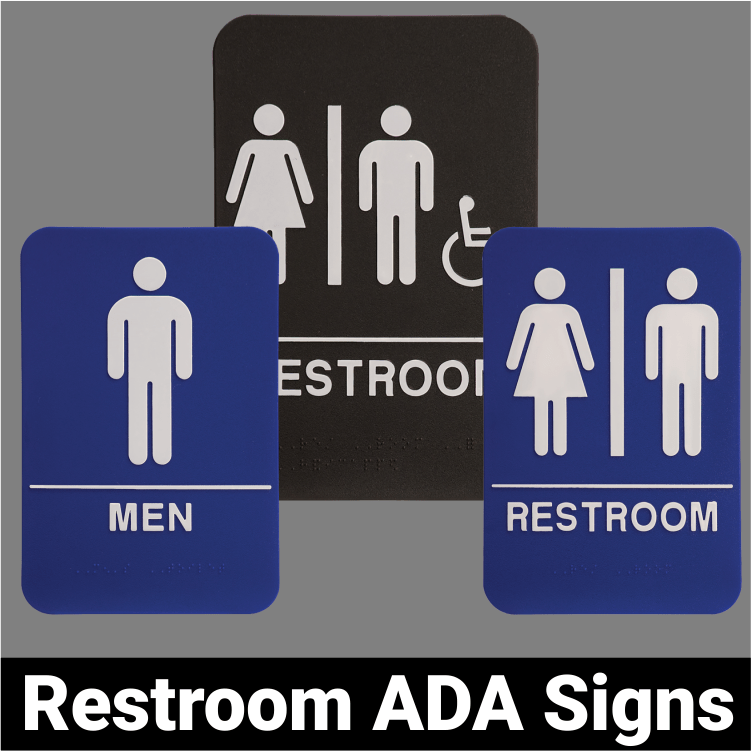The Influence of ADA Signs on Community Ease Of Access
The Influence of ADA Signs on Community Ease Of Access
Blog Article
Checking Out the Secret Functions of ADA Indications for Improved Availability
In the world of access, ADA indicators function as silent yet powerful allies, guaranteeing that spaces are navigable and comprehensive for individuals with disabilities. By incorporating Braille and responsive elements, these signs break obstacles for the aesthetically impaired, while high-contrast color design and readable typefaces accommodate varied aesthetic demands. Their calculated placement is not approximate however rather a computed effort to help with seamless navigation. Yet, past these functions lies a much deeper story regarding the evolution of inclusivity and the recurring dedication to developing equitable rooms. What extra could these indications signify in our quest of universal access?
Importance of ADA Compliance
Making certain compliance with the Americans with Disabilities Act (ADA) is essential for promoting inclusivity and equivalent access in public spaces and offices. The ADA, enacted in 1990, mandates that all public facilities, companies, and transport solutions accommodate individuals with specials needs, guaranteeing they appreciate the very same legal rights and chances as others. Conformity with ADA criteria not just fulfills legal commitments yet also improves an organization's track record by showing its dedication to variety and inclusivity.
Among the vital aspects of ADA compliance is the application of available signage. ADA signs are developed to make sure that people with specials needs can conveniently navigate with structures and rooms. These signs need to follow certain guidelines concerning size, font, color comparison, and positioning to ensure visibility and readability for all. Appropriately applied ADA signs assists eliminate obstacles that people with disabilities often encounter, thereby promoting their freedom and confidence (ADA Signs).
Moreover, adhering to ADA guidelines can reduce the threat of lawful repercussions and potential fines. Organizations that fail to follow ADA standards may encounter penalties or legal actions, which can be both damaging and financially challenging to their public picture. Hence, ADA compliance is indispensable to fostering an equitable setting for everyone.
Braille and Tactile Components
The incorporation of Braille and responsive aspects right into ADA signage symbolizes the concepts of access and inclusivity. These attributes are vital for individuals who are blind or aesthetically damaged, enabling them to navigate public rooms with greater independence and confidence. Braille, a responsive writing system, is essential in offering created information in a format that can be quickly regarded through touch. It is generally positioned below the matching message on signs to make sure that individuals can access the info without aesthetic aid.
Responsive components expand past Braille and include increased icons and personalities. These parts are designed to be noticeable by touch, enabling individuals to identify room numbers, restrooms, leaves, and various other essential locations. The ADA sets details standards pertaining to the dimension, spacing, and placement of these tactile elements to maximize readability and make sure consistency across different environments.

High-Contrast Color Pattern
High-contrast color schemes play a critical duty in enhancing the visibility and readability of ADA signs for individuals with aesthetic disabilities. These schemes are essential as they make the most of the difference in light reflectance between message and background, making sure that signs are easily noticeable, even from a range. The Americans with Disabilities Act (ADA) mandates making use of details color contrasts to accommodate those with the original source minimal vision, making it an important facet of compliance.
The efficiency of high-contrast colors depends on their ability to stand out in various lighting problems, including poorly lit environments and locations with glow. Usually, dark text on a light history or light text on a dark background is utilized to attain optimum comparison. As an example, black text on a yellow or white history offers a plain aesthetic difference that helps in fast acknowledgment and comprehension.

Legible Fonts and Text Dimension
When considering the design of ADA signs, the choice of legible fonts and suitable text dimension can not be overemphasized. These components are crucial for guaranteeing that indications come to individuals with visual disabilities. The Americans with Disabilities Act (ADA) mandates that font styles need to be not italic and sans-serif, oblique, manuscript, highly decorative, or of unusual kind. These needs aid guarantee that the text is quickly understandable from a distance and that the personalities are distinguishable to diverse audiences.
The size of the message additionally plays an essential function in ease of access. According to ADA guidelines, the minimum text elevation must be 5/8 inch, and it must enhance proportionally with checking out range. This is especially crucial in public spaces where signage needs to be read quickly and properly. Uniformity in text size adds to a cohesive aesthetic experience, helping individuals in browsing atmospheres efficiently.
Moreover, spacing in between lines and letters is essential to readability. Sufficient spacing prevents characters from showing up crowded, enhancing readability. By sticking to these standards, developers can significantly enhance availability, making sure that signs serves its designated objective for all individuals, regardless of their visual abilities.
Reliable Placement Techniques
Strategic positioning of ADA signs is vital for optimizing accessibility and making sure conformity with lawful standards. Appropriately located signs assist individuals with disabilities effectively, promoting navigation in public spaces. Secret factors to consider consist of height, visibility, and proximity. ADA standards state that indicators ought to be mounted at an elevation between 48 to 60 inches from the ground to guarantee they are within the line of sight for both standing and seated people. This conventional elevation variety is important for inclusivity, making it possible for mobility device customers and individuals of varying elevations to accessibility details easily.
In addition, indications must Bonuses be put surrounding to the latch side of doors to allow simple recognition before entry. Consistency in sign positioning throughout a facility improves predictability, reducing complication and improving general user experience.

Final Thought
ADA indicators play an important duty in promoting availability by integrating functions that attend to the requirements of people with disabilities. Integrating Braille and responsive elements makes sure essential information comes to the aesthetically damaged, while high-contrast color pattern and readable sans-serif typefaces boost visibility across numerous illumination problems. Reliable positioning strategies, such as suitable mounting elevations and calculated places, better promote navigating. These elements jointly promote an inclusive environment, underscoring the importance of ADA compliance in guaranteeing equal gain access to for all.
In the world of access, ADA indicators offer as quiet yet effective allies, guaranteeing that spaces are navigable and comprehensive for people with disabilities. The ADA, passed in 1990, mandates that all public facilities, employers, and transportation services accommodate people with impairments, ensuring they appreciate the exact same legal rights and opportunities as others. ADA Signs. ADA indicators are made to make sure that individuals with handicaps can quickly navigate through buildings and rooms. ADA guidelines specify that indications ought to be mounted at an elevation between 48 to 60 inches from the ground to guarantee they are within the line of sight for both standing and seated people.ADA indications play an important role in advertising ease of access by incorporating features that resolve the requirements of individuals with handicaps
Report this page